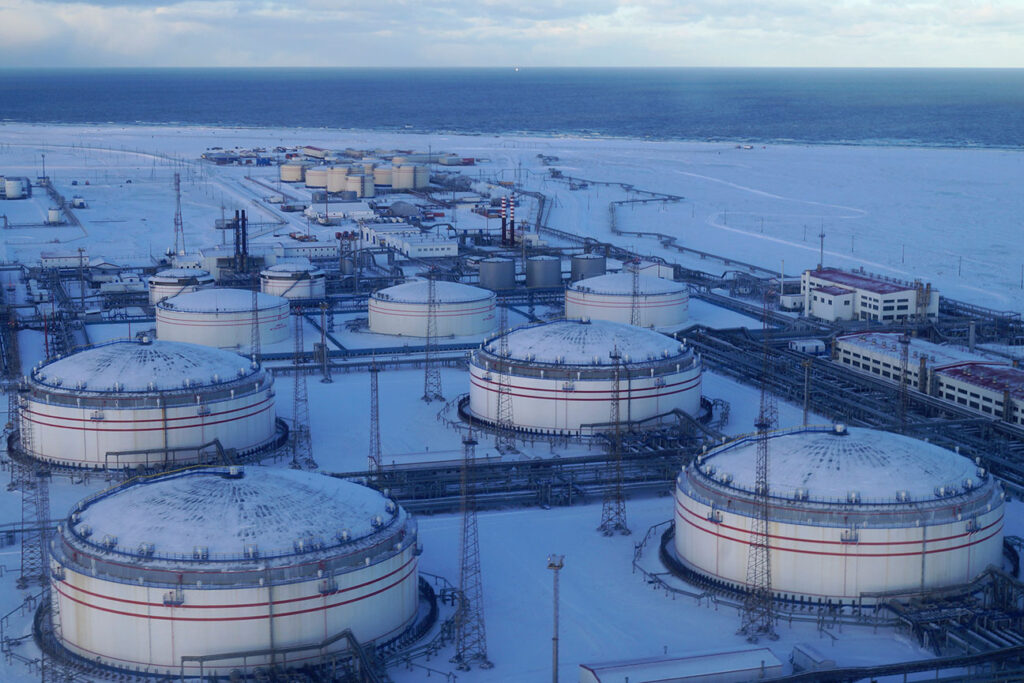An aerial view shows a storage facility owned by Lukoil Oil Co. at the Arctic port of Varandey. REUTERS
REUTERS
Russia’s Arctic oil exports to China rose sharply in April, buoyed by a jump in ship-to-ship transfers at sea to ensure tankers pulling into port are not on U.S. sanctions lists, according to traders and data from the oil analytics firm Vortexa. The Arctic oil business accounts for 10% of Russia’s seaborne oil exports, which were hit with widened U.S. sanctions in January 2025 on nearly all tankers carrying crude oil grades such as ARCO and Novy Port and on Russian producer Gazprom Neft.
To evade the curbs, ship-to-ship (STS) transfers of cargoes are taking place in international waters off Singapore and Malaysia, where cargoes are loaded onto very large crude carriers (VLCCs) that are not subject to sanctions before heading for Chinese ports, according to traders and Vortexa senior analyst Emma Li. At least 4 million barrels of Arctic oil completed STS in early April and 16 million more have arrived or were expected to arrive in the South China Sea in April, Li estimated.
China’s Arctic oil imports are rebounding given ample supply, but the volume eventually discharged will vary depending on logistics hurdles and buying interest from Chinese refiners, she added.
China’s imports of Arctic oil from Russia in March averaged 25,000 barrels per day, according to Vortexa. China has said it opposes unilateral sanctions, which have been imposed by the United States, EU and others aimed at curbing Russian, Iranian and Venezuelan energy revenue.
Yet STS transfers are being used, according to one trader, because many Chinese buyers want to avoid being linked to tankers subject to such sanctions as they are wary of secondary sanctions and are willing to pay higher prices for these STS cargoes. For example, the VLCC Atila loaded 2.07 million barrels of ARCO from two sanctioned tankers in March in waters off Singapore and delivered the cargo to China’s port of Dongying in eastern Shandong province in April, Kpler data shows.
Atila previously engaged in STS transfers involving Iranian oil. Arctic grades — ARCO, Novy Port and Varandey — are produced in Russia’s northern regions, where harsh winter weather affects production and oil projects require huge investment.
These grades are typically shipped from oil fields to floating storage in Murmansk and then shipped to end users, making it difficult to track exports of each grade. These shipments currently take two months to reach China as tankers are traveling via the Suez Canal, with the STS adding to shipping costs. The shorter North Sea Route (NSR) to China is closed until July. “It’s a very long and expensive route,” one trader said. “The only idea is to evacuate barrels.”
Light Arctic oil is offered at discounts to benchmark Brent prices, down from premiums previously, the traders said. Not all the Arctic oil cargoes are set to find a home soon as some of them are being stored on ships, traders said.
For instance, tanker Fast Kathy loaded Arctic oil in Murmansk on March 14 and has been floating off Port Said in Egypt since April 9, LSEG data showed. India, previously the top buyer of Arctic oil, has cut purchases due to sanctions, traders said. Arctic oil is going to India mostly from the Varandey field developed by Russia’s Lukoil, they added.
In April, Indian authorities barred a tanker from conducting an STS operation off the port of Mumbai involving a cargo of Russian crude. Other Arctic oil buyers include Syria, which received its first shipments earlier this year, and Myanmar.

